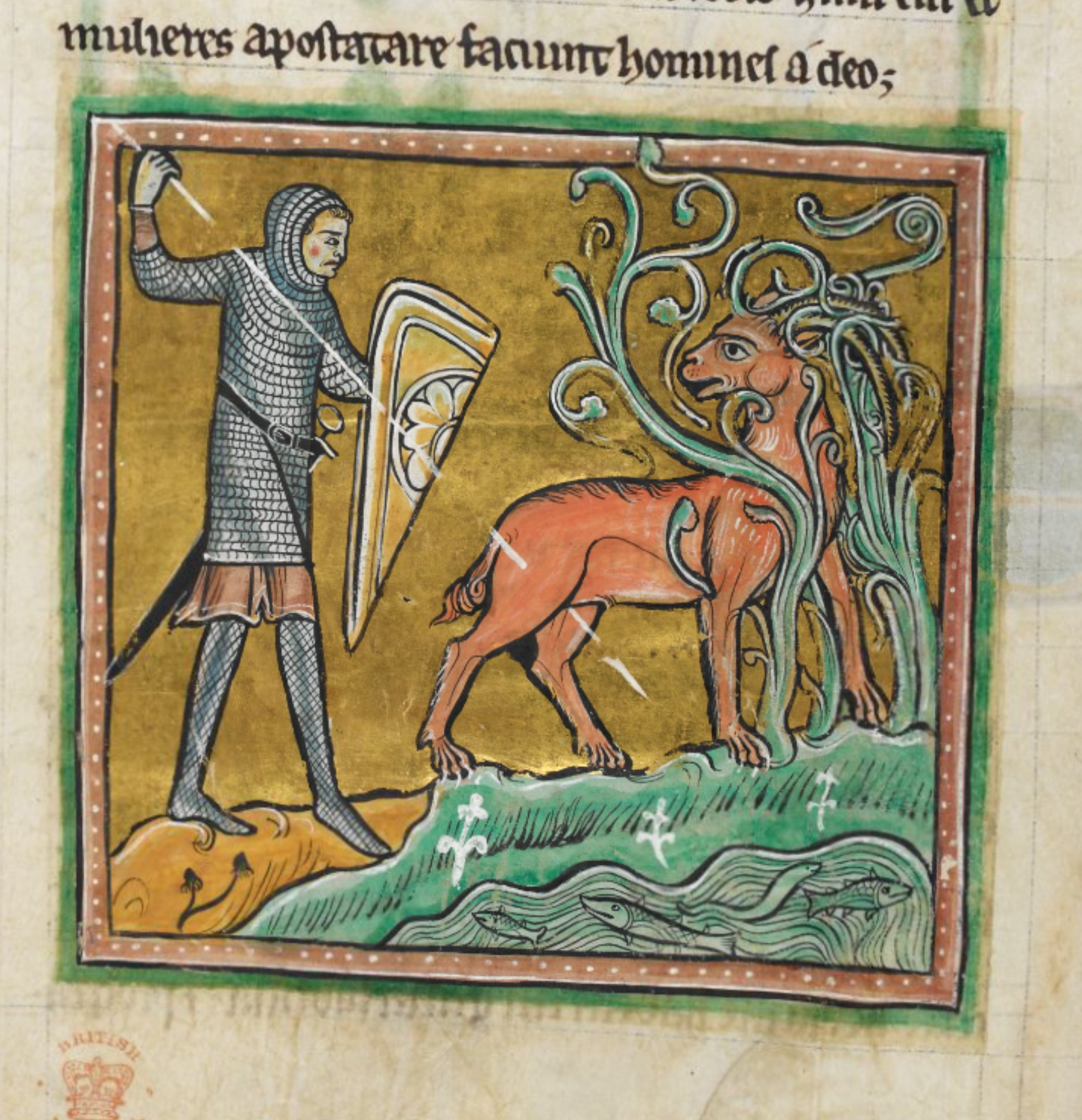Antelope, Rochester Bestiary, c.1230
The antelope was sometimes associated with virtue and spiritual struggle. Due to its graceful and gentle nature, the antelope represented chastity and virtue as well as the importance of leading a virtuous and chaste life.
The watchfulness and the ability of this animal to detect danger symbolised the need for Christians to be spiritually vigilant and aware of the danger of sin and temptation.
The antelope’s two horns symbolised the Old and the New Testament, with which Christians could free themselves from vices and from the temptation of lust and other mundane pleasures.
re. Habet autem longa cornua; serre figuram ha-
bentia. ut possit resecare arbores altas et magnas
et ad terram prosternere. Cum autem sicierit1 vadit ad
flumen magnum euphraten. Est autem ibi frutex qui
dicitur hericine habens virgulta subtilia. et prolixa.
Now, there is an animal called antelope and is very fierce indeed, insomuch that even a hunter cannot approach it. It has long horns that have a saw-like shape, so that it can cut down tall and large trees and lay them to the ground. When it is thirsty, it goes to the large river Euphrates. There are shrubs there that have delicate and long shoots, resembling a porcupine.2 It begins to play with its horns in the bushes
obligat cornua in virgultis eius. et diu pugnans;
cum se liberare non potest; exclamat voce magna Audiens venator vocem eius; venit et occidit eum. Sic
et tu homo qui studes sobrius esse et castus; et spiritualiter
vivere; cuius duo cornua sunt duo testamenta. per que
poteris resecare et excidere omnia vicia; corporalia et
spiritualia. Cave ab ebrietate. Ne obligeris luxuria
et voluptate. et interficiaris a diabolo. Vinum enim et
mulieres apostatare faciunt homines a deo.
and whilst playing, its horns are entangled in the shrubs. It struggles for a long time and since it cannot free itself, it bleats loudly. Hearing its bleat, the hunter comes and kills it. Thus, you, Man, that you strive to be sober and chaste, and live spiritually, whose two horns are the two Testaments through which you can cut and eliminate all vices, both physical and spiritual? Beware of inebriation. Do not entangle yourself in lechery, pleasure, and do not let the devil tempt and destroy you, for wine and women lead men away from God.
Bibliography
David Badke, The Bestiary Blog: Animals in the Middle Ages, Antelope, November 6 2023, https://bestiary.ca/beasts/beast137.htm
Josh Goldenberg (BA 2012) and Matt Shanahan (BA 2014, Logeion, November 2022, https://logeion.uchicago.edu/
Castiglioni, L. and Mariotti, S. (1996). Vocabolario della Lingua Latina: Latino-Italiano Italiano-Latino. Terza Edizione. Loescher Torino
Matthews, J. and Matthews C., (2010), The Element Encyclopedia of Magical Creatures, HarperCollins UK, London
Curley, M. J., Physiologus: A Medieval Book of Nature Lore (University of Chicago edition 2009)
Rackham, H., M.A., Pliny Natural History Volume III, Libri VIII-XI (London: William Heinemann Ltd, 1949)
Collins, A. H., M.A., Symbolism of Animals and Birds (New York: McBride, Nast & Company, 1913)
Henderson, C., The Book of Barely Imagined Beings (London: University of Chicago Press, 2013)
White, T. H., The Bestiary: A Book of Beasts (New York: G.P Putnam’s Sons, 1960)
Barney, S. A., Lewis, W. J., Beach A., Berghof O., The Etymologies of Isidore of Seville (New York: Cambridge University Press, 2006)
Footnotes
1 Late Latin for sĭtĭerit from sĭtīre to be thirsty.
2 Hericine might be Late Latin for ērīcīnus: related to the porcupine. It might be referring to the plant Miscanthus Sinensis 'Strictus' known as porcupine grass.
https://www.rhs.org.uk/plants/81707/miscanthus-sinensis-strictus-(v)/details

